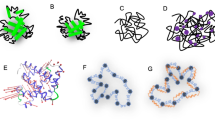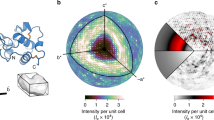Abstract
Structural fluctuations in proteins on the picosecond timescale have been studied in considerable detail by theoretical methods such as molecular dynamics simulation1,2, but there exist very few experimental data with which to test the conclusions. We have used the technique of inelastic neutron scattering to investigate atomic motion in hydrated myoglobin over the temperature range 4–350 K and on the molecular dynamics timescale 0.1–100 ps. At temperatures below 180 K myglobin behaves as a harmonic solid, with essentially only vibrational motion. Above 180 K there is a striking dynamic transition arising from the excitation of non-vibrational motion, which we interpret as corresponding to tor-sional jumps between states of different energy, with a mean energy asymmetry of KJ mol −1. This extra mobility is reflected in a strong temperature dependence of the mean-square atomic displacements, a phenomenon previously observed specifically for the heme iron by Mossbauer spectroscopy3–5, but on a much slower timescale (10−7 s). It also correlates with a glass-like transition in the hydration shell of myoglobin6 and with the temperature-dependence of ligand-binding rates at the heme iron, as monitored by flash photolysis7. In contrast, the crystal structure of myoglobin determined down to 80 K shows no significant structural transition8–10. The dynamical behaviour we find for myoglobin (and other globular proteins) suggests a coupling of fast local motions to slower collective motions, which is a characteristic feature of other dense glass-forming systems.
This is a preview of subscription content, access via your institution
Access options
Subscribe to this journal
Receive 51 print issues and online access
$199.00 per year
only $3.90 per issue
Buy this article
- Purchase on Springer Link
- Instant access to full article PDF
Prices may be subject to local taxes which are calculated during checkout
Similar content being viewed by others
References
McCammon, J. A. Rep. Prog. Phys. 47, 1–46 (1984).
Levy, R. M. et al. Biophys. J. 48, 509–518 (1985).
Parak, F. et al. FEBS Lett. 117, 368–372 (1980).
Keller, H. & Debrunner, P. Phys. Rev. Lett. 45, 68–71 (1980).
Bauminger, E. R., Cohen, S. G., Nowik, I., Ofer, S. & Yariv, J. Proc. natn. Acad. Sci. U.S.A. 80, 736–740 (1983).
Doster, W., Bachleitner, A., Dunau, R., Hieble, M. & Lüscher, E. Biophys. J. 50, 213–219 (1986).
Austin, R. H., Beeson, K. W., Eisenstein, L., Frauenfelder, H. & Gunsales, I. C. Biochemistry 14, 5355–5373 (1975).
Frauenfelder, H., Petsko, G. A. & Tsernoglou, D. Nature 280, 558–563 (1979).
Hartmann, H. et al. Proc. natn. Acad. Sci. U.S.A. 79, 4967–4971 (1982).
Parak, F. et al. Eur. Biophys. J. 15, 237–249 (1987).
Cusack, S. in The Enzyme Catalysis Process: Energetics, Mechanism and Dynamics (eds Cooper, A. & Houben, J. (NATO ASI series, Plenum, London, in the press).
Springer, T. in Quasielastic Neutron Scattering for the Investigation of Diffusive Motions in Solids and Liquids (Springer Tracts in Modern Physics, Vol. 64, 1972).
Bee, M. in Quasielastic Neutron Scattering: Principles and Applications in Solid-state Chemistry, Biology and Materials Science (Hilger, Bristol, 1988).
Stöckli, H., Furrer, A., Schoenenberger, Ch., Meier, B. H., Ernst, R. R. & Anderson, I. Physica 136B, 161–164 (1986).
Levitt, M. J. molec. Biol. 168, 621–657 (1983).
Cusack, S., Smith J., Finney, J., Tidor, B. & Karplus, M. J. molec. Biol. 202, 903–908 (1988).
Frick, B., Richter, D., Petry, W. & Buchenau, U. Z. Phys. B70, 1–3 (1988).
Davidson, D. W. & Cole, R. H. J. chem. Phys. 18, 1417–1419 (1950).
Bengtzelius, W., Gotze, W. & Sjölander, A. J. Phys. C17, 5915–5933 (1984).
Götze, W. & Sjögren, L. J. Phys. C20, 879–894 (1987).
Götze, W. & Sjögren, L. J. Phys. C21, 3407–3471 (1988).
Doster, W., Cusack, S. & Petry, W. Proc. ILL Workshop Dynamics of Disordered Materials, Grenoble, 1988.
Poglitsch, H., Kremer, F. & Genzel, L. J. molec. Biol. 173, 137–142 (1984).
Parak, F., Heidemeier, J. & Nienhaus, G. U. Hyperfine Interactions 40, 147–158 (1988).
Elber, R. & Karplus, M. Science 235, 318–321 (1987).
Neutron Research Facilities at the ILL High-Flux Reactor (Institut Laue-Langevin, Grenoble, 1988).
Author information
Authors and Affiliations
Rights and permissions
About this article
Cite this article
Doster, W., Cusack, S. & Petry, W. Dynamical transition of myoglobin revealed by inelastic neutron scattering. Nature 337, 754–756 (1989). https://doi.org/10.1038/337754a0
Received:
Accepted:
Issue Date:
DOI: https://doi.org/10.1038/337754a0
This article is cited by
-
Unfreezing of molecular motions in protein-polymer conjugates: a calorimetric study
Journal of Thermal Analysis and Calorimetry (2022)
-
A Minireview on Temperature Dependent Protein Conformational Sampling
The Protein Journal (2021)
-
Neutron scattering in photosynthesis research: recent advances and perspectives for testing crop plants
Photosynthesis Research (2021)
-
A Quantitative Comparison of the Counting Significance of van Hove Integral Spectroscopy and Quasielastic Neutron Scattering
Scientific Reports (2020)
-
Dynamics of proteins with different molecular structures under solution condition
Scientific Reports (2020)
Comments
By submitting a comment you agree to abide by our Terms and Community Guidelines. If you find something abusive or that does not comply with our terms or guidelines please flag it as inappropriate.



